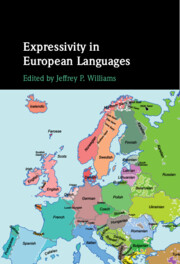Book contents
- Expressivity in European Languages
- Expressivity in European Languages
- Copyright page
- Contents
- Figures
- Tables
- Contributors
- 1 Introduction
- Uralic
- Germanic
- Hellenic
- Romance
- 7 Repetition and reduplication in Italian
- 8 Analysing expressives in a spoken corpus of Majorcan Catalan
- Celtic
- Vasconian
- Caucasian
- Comparative
- Index
- References
7 - Repetition and reduplication in Italian
from Romance
Published online by Cambridge University Press: 24 August 2023
- Expressivity in European Languages
- Expressivity in European Languages
- Copyright page
- Contents
- Figures
- Tables
- Contributors
- 1 Introduction
- Uralic
- Germanic
- Hellenic
- Romance
- 7 Repetition and reduplication in Italian
- 8 Analysing expressives in a spoken corpus of Majorcan Catalan
- Celtic
- Vasconian
- Caucasian
- Comparative
- Index
- References
Summary
The chapter surveys repetitions and reduplications in Italian, from the segmental to the discourse level. Italian has reduplicative structures in ideophones, onomatopoeic formations, child language, and baby talk; segment repetition is used as an expressive device in commercials and product names; reduplication is used as a lexeme formation device in Verb-Verb compounds such as fuggifuggi ‘stampede, lit. run away run away’, and as a means of intensification of adjectives and adverbs; some sequences of two nouns have lexicalized with adjectival or adverbial meaning; contrastive focus reduplication is also attested in Italian. Discourse markers are often reduplicated; several cases of repetition of imperatives in discourse have constructionalized, giving rise to converbs with concessive or hypothetical meanings or used as antecedents of consecutive clauses; noun reiteration in discourse can be used to indicate frequency of occurrence of entities and events. It is argued that no clear dividing line can be drawn between pragmatic or syntactic repetition and grammatical or morphological reduplication, since grammaticalization of discourse repetition in diachrony often occurs.
Keywords
- Type
- Chapter
- Information
- Expressivity in European Languages , pp. 231 - 268Publisher: Cambridge University PressPrint publication year: 2023

